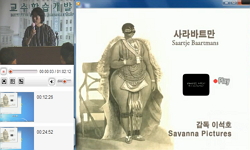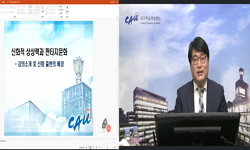This thesis mainly discussed the characteristics of imagination in the tales of mystery and the supernatural. In the chapter one, the function of imagination in the tales and the meaning of imagination in the classical books before and in the Six Dyn...
http://chineseinput.net/에서 pinyin(병음)방식으로 중국어를 변환할 수 있습니다.
변환된 중국어를 복사하여 사용하시면 됩니다.
- 中文 을 입력하시려면 zhongwen을 입력하시고 space를누르시면됩니다.
- 北京 을 입력하시려면 beijing을 입력하시고 space를 누르시면 됩니다.
https://www.riss.kr/link?id=T10089372
- 저자
-
발행사항
北京 : 中國社會科學院, 2004
-
학위논문사항
Thesis(doctoral) -- 中國社會科學院 , [중국고대문학전공] , 2004
-
발행연도
2004
-
작성언어
중국어
- 주제어
-
KDC
820 판사항(4)
-
형태사항
74, vip. ; 26cm.
-
일반주기명
References: p. i-vi
- 소장기관
-
0
상세조회 -
0
다운로드
부가정보
다국어 초록 (Multilingual Abstract)
In the chapter one, the function of imagination in the tales and the meaning of imagination in the classical books before and in the Six Dynasties are studied. At first, the fabrication in the tales of mystery and the supernatural, and then, the imagination from between fact and fabrication are studied. Besides, the function of game and banter in the tales of mystery and the supernatural is analyzed. About the classical books before the Six Dynasties, the concept of imagination in the Hanfeizi, Zhuangzi Chuci and so on is investigated; about the period of the Six Dynasties, the meaning of imagination in the works is discussed on the basis of the Wenfu and Wenxindiaolong. In addition, the meaning of imagination in the drawing theory in the Six Dynasties is observed mainly from Gu Kaizhi's drawing theory.
In the chapter two, the relation between the imagination and the geographical factor is analyzed. At first, the cause is discussed that the tales of mystery and the supernatural mainly appeared in the Eastern Jin Dynasty and southern area by discussing the background of society and culture. Then, the native places, the living times and areas of the tales writers are discussed. The relation between the imagination and the geographical factor on the basic of the regions of the tales in the Soshenji and Youmihglu is discussed. The relation between the imagination of the tales of mystery and the supernatural and southern culture is analyzed mainly from romanticism of southern culture, worship of totems and religion. The pluralism of imagination in the tales of mystery and the supernatural is analyzed.
In the chapter three, imagination and narration out of shape are studied. The concept of object in the Six Dynasties in the dismemberment, the imagination of obj ect of the ancient times, and the relation among obj ect, dismemberment and imagination are analyzed. The narration out of shape contains the one of dismemberment, the one of animals and plants, the one of persons and ghosts. The characteristics of imagination in these types are analyzed.
In the chapter four, the relation between imagination and the unusual narration is probed. The unusual narration includes the one of unusual areas, the one of paradise, the one of gloom and the one of hell. The narration of unusual areas is about the foreign countries including foreign countries, foreigners and foreign things. The tales are mainly in the Bowuzhi and Xuanzhongji, showing the imagination of the special space. The narration of paradise embodies hopes of the ideal world and imagination of the Six Dynasties. The narration of gloom displays the imagination of living and death and the concept of gloom. The effect of Buddhism imagination in the tales of mystery and the supF?~atural is investigated mainly from the narration of hell from Buddhism. In the chapter five, the effect of imagination of tales of mystery and the supernatural in the Six Dynasties in the tales of the marvelous in the Tang Dynasty and in the novels in the Ming-Qing period is investigated. The effect of imagination in tales of the marvelous in the Tang Dynasty is analyzed mainly from the narration of love between human being and spirit, mirrors and the cavities. The effect of imagination of Liaozhaizhiyi and Yueweitahgbiji is discussed mainly the narration out of shape.
This thesis tries mainly to reveal imagination in the tales of mystery and the supernatural in the Six Dynasties by the studying way and content above.
This thesis mainly discussed the characteristics of imagination in the tales of mystery and the supernatural.
In the chapter one, the function of imagination in the tales and the meaning of imagination in the classical books before and in the Six Dynasties are studied. At first, the fabrication in the tales of mystery and the supernatural, and then, the imagination from between fact and fabrication are studied. Besides, the function of game and banter in the tales of mystery and the supernatural is analyzed. About the classical books before the Six Dynasties, the concept of imagination in the Hanfeizi, Zhuangzi Chuci and so on is investigated; about the period of the Six Dynasties, the meaning of imagination in the works is discussed on the basis of the Wenfu and Wenxindiaolong. In addition, the meaning of imagination in the drawing theory in the Six Dynasties is observed mainly from Gu Kaizhi's drawing theory.
In the chapter two, the relation between the imagination and the geographical factor is analyzed. At first, the cause is discussed that the tales of mystery and the supernatural mainly appeared in the Eastern Jin Dynasty and southern area by discussing the background of society and culture. Then, the native places, the living times and areas of the tales writers are discussed. The relation between the imagination and the geographical factor on the basic of the regions of the tales in the Soshenji and Youmihglu is discussed. The relation between the imagination of the tales of mystery and the supernatural and southern culture is analyzed mainly from romanticism of southern culture, worship of totems and religion. The pluralism of imagination in the tales of mystery and the supernatural is analyzed.
In the chapter three, imagination and narration out of shape are studied. The concept of object in the Six Dynasties in the dismemberment, the imagination of obj ect of the ancient times, and the relation among obj ect, dismemberment and imagination are analyzed. The narration out of shape contains the one of dismemberment, the one of animals and plants, the one of persons and ghosts. The characteristics of imagination in these types are analyzed.
In the chapter four, the relation between imagination and the unusual narration is probed. The unusual narration includes the one of unusual areas, the one of paradise, the one of gloom and the one of hell. The narration of unusual areas is about the foreign countries including foreign countries, foreigners and foreign things. The tales are mainly in the Bowuzhi and Xuanzhongji, showing the imagination of the special space. The narration of paradise embodies hopes of the ideal world and imagination of the Six Dynasties. The narration of gloom displays the imagination of living and death and the concept of gloom. The effect of Buddhism imagination in the tales of mystery and the supF?~atural is investigated mainly from the narration of hell from Buddhism. In the chapter five, the effect of imagination of tales of mystery and the supernatural in the Six Dynasties in the tales of the marvelous in the Tang Dynasty and in the novels in the Ming-Qing period is investigated. The effect of imagination in tales of the marvelous in the Tang Dynasty is analyzed mainly from the narration of love between human being and spirit, mirrors and the cavities. The effect of imagination of Liaozhaizhiyi and Yueweitahgbiji is discussed mainly the narration out of shape.
This thesis tries mainly to reveal imagination in the tales of mystery and the supernatural in the Six Dynasties by the studying way and content above.
목차 (Table of Contents)
- 目次 = i
- 內容提要
- Abstract
- 前言 = 1
- 第一章 古代想像力的歸納與特徵 = 4
- 目次 = i
- 內容提要
- Abstract
- 前言 = 1
- 第一章 古代想像力的歸納與特徵 = 4
- 第一節 古代中國小說與想像力 = 4
- 第二節 魏晋南北朝之前想像力的意義與功能 = 6
- 第三節 魏晋南北朝時期的想像力 = 9
- 第二章 想像力、志怪小說和地理因素 = 11
- 第一節 六朝時期社會文化的背景 = 11
- 1 六朝時期社會經濟變化 = 11
- 2 各個地域的志怪作家 = 13
- 第二節 南方文化與志怪小說 = 15
- 1 南方文化的特徵 = 15
- 2 志怪小說與南方的浪慢性 = 16
- 3 志怪小說與南方的圖騰崇拜 = 18
- 4 志怪小說與南方的宗敎母題 = 21
- 第三節 想像力與志怪小說中的多元性 = 21
- 第三章 想像力與變形敍事 = 25
- 第一節 變形敍事與六朝人的思想觀念 = 25
- 1 六朝人的物觀念 = 25
- 2 變形敍事與哲學宗敎思 = 27
- 第二節 變形敍事的類型分析 = 29
- 1 肢解型 = 29
- 2 動物變形 = 30
- 3 人鬼變形型 = 33
- 第三節 變形敍事與逐鬼文化 = 33
- 第四章 想像力與異怪敍事 = 36
- 第一節 想像力與殊域敍事 = 36
- 1 異域敍事 = 36
- 2 樂園敍事 = 39
- 第二節 想像力與幽冥敍事 = 42
- 1 道敎與幽冥敍事 = 42
- 2 佛敎與地獄敍事 = 45
- 第五章 六朝志怪小說的想像力對後代小說的影響 = 47
- 第一節 唐傳奇與六朝志怪的想像力 = 47
- 第二節 明淸小說與六朝志怪的想像力 = 48
- 結語 = 50
- 附錄 = 51
- 《幽明錄》地理分布圖 = 51
- 《搜神記》地理分布圖 = 62
- 主要參考文獻 = i












